七年级英语:第十课 Lesson Ten(教学方案)
北师大版英语七年级下册Lesson10教学设计

4.教师通过角色扮演、情景剧等形式,为学生提供实际语境,让学生在互动中练习一般过去时的表达。
(三)学生小组讨论
1.教师将学生分成小组,每组选择一个假期话题进行讨论,如“Spring Festival”, “Summer Vacation”等。
2.学生在规定时间内完成练习,教师对答案进行讲解,并针对学生的错误进行指导。
3.教师鼓励学生互相批改练习,提高学生的自主学习能力和合作意识。
(五)总结归纳
1.教师邀请学生回顾本节课的学习内容,总结一般过去时的用法和关键点。
2.教师强调词汇和句型在英语学习中的重要性,提醒学生课后加强复习和练习。
3.教师鼓励学生在日常生活中用英语记录和分享自己的经历,提高英语实际运用能力。
三、教学重难点和教学设想
(一)教学重难点
1.重点:本课的重点在于学生能够运用一般过去时描述过去的事情,掌握相关的词汇和句型,如“holiday”, “activity”, “festival”以及“I visited my grandparents during the summer holiday.”等。
a.课前准备:教师提前准备与本课相关的图片、视频等教学资源,以便在课堂上创设情境,激发学生的学习兴趣。
b.课堂导入:通过提问方式引导学生回顾过去的假期生活,为新课的学习做好铺垫。
c.新课呈现:教师展示与本课相关的图片和视频,引导学生学习新词汇和句型,同时讲解一般过去时的用法。
d.小组活动:学生分成小组,用一般过去时讨论并分享各自的假期经历,提高口语表达能力。
2.学生在小组内用一般过去时分享各自的经历,如:“I cleaned my room during the Spring Festival.”,并鼓励其他小组成员提问和补充。
七年级英语上册 Unit 10 Can you play the guitar公开课教案 人教新目标版
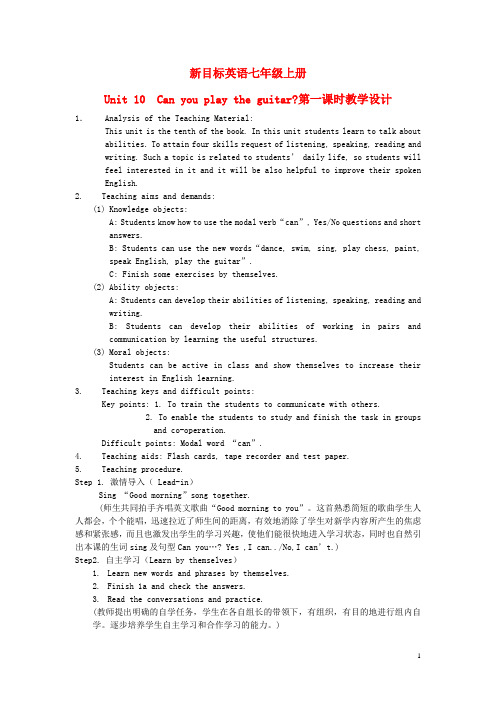
新目标英语七年级上册Unit 10 Can you play the guitar?第一课时教学设计1.Analysis of the Teaching Material:This unit is the tenth of the book. In this unit students learn to talk about abilities. To attain four skills request of listening, speaking, reading and writing. Such a topic is related to students’ daily life, so students will feel interested in it and it will be also helpful to improve their spoken English.2.Teaching aims and demands:(1)Knowledge objects:A: Students know how to use the modal verb“can”, Yes/No questions and short answers.B: Students can use the new words“dance, swim, sing, play chess, paint, speak English, play the guitar”.C: Finish some exercises by themselves.(2)Ability objects:A: Students can develop their abilities of listening, speaking, reading and writing.B: Students can develop their abilities of working in pairs and communication by learning the useful structures.(3)Moral objects:Students can be active in class and show themselves to increase their interest in English learning.3.Teaching keys and difficult points:Key points: 1. To train the students to communicate with others.2. To enable the students to study and finish the task in groupsand co-operation.Difficult points: Modal word “can”.4.Teaching aids: Flash cards, tape recorder and test paper.5.Teaching procedure.Step 1. 激情导入( Lead-in)Sing “Good morning”song together.(师生共同拍手齐唱英文歌曲“Good morning to you”。
甘肃省会宁太平中学2013-2014学年七年级英语上册Lesson10教案
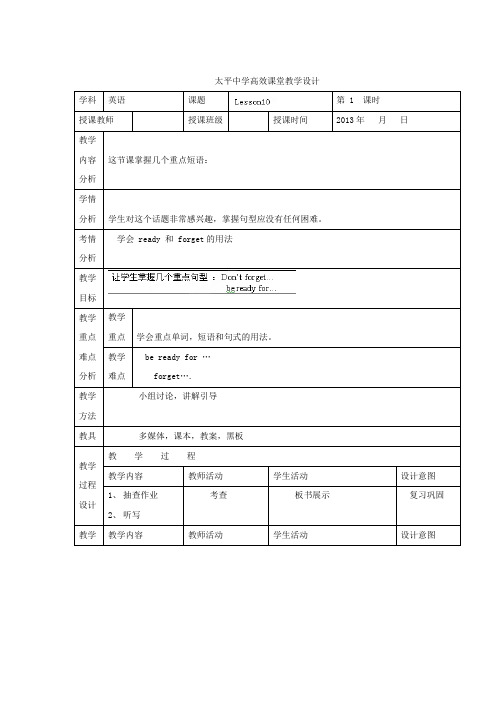
太平中学高效课堂教学设计
学科英语课题第 1 课时
授课教师授课班级授课时间2013年月日教学
内容
分析
这节课掌握几个重点短语:
学情
分析学生对这个话题非常感兴趣,掌握句型应没有任何困难。
考情
分析
学会 ready 和 forget的用法
教学
目标
教学重点难点分析教学
重点学会重点单词,短语和句式的用法。
教学
难点
be ready for …
forget….
教学
方法
小组讨论,讲解引导
教具多媒体,课本,教案,黑板
教学过程设计教学过程
教学内容教师活动学生活动设计意图
1、抽查作业
2、听写
考查板书展示复习巩固
教学教学内容教师活动学生活动设计意图。
人教版新目标七年级英语下册 Unit 10教学设计(5课时)

人教版新目标七年级英语下册 Unit 10教学设计(5课时)一. 教材分析人教版新目标七年级英语下册Unit 10主要讲述了关于日常生活中的不同职业和人们的工作内容。
通过本单元的学习,学生能够掌握与职业相关的词汇和表达方式,听懂、会说、会读关于不同职业的对话,并能够运用所学知识进行简单的交流。
教材内容丰富,贴近学生生活,有利于激发学生的学习兴趣,提高学生的英语交际能力。
二. 学情分析七年级的学生已经掌握了基本的英语语法和词汇知识,具备一定的听、说、读、写能力。
但部分学生对英语学习仍存在恐惧心理,缺乏自信心。
针对这一情况,教师应关注学生的个体差异,鼓励学生积极参与课堂活动,增强学生的自信心。
此外,学生对日常生活中的不同职业有一定的了解,但可能对某些职业的具体工作内容不够清楚,教师应在教学中予以补充和拓展。
三. 教学目标1.知识目标:学生能够掌握与职业相关的词汇和表达方式,了解不同职业的工作内容。
2.能力目标:学生能够听懂、会说、会读关于不同职业的对话,并能够运用所学知识进行简单的交流。
3.情感目标:培养学生对不同职业的尊重和理解,拓宽视野,树立正确的职业观念。
四. 教学重难点1.重点:学生能够掌握与职业相关的词汇和表达方式,听懂、会说、会读关于不同职业的对话。
2.难点:学生能够运用所学知识进行简单的交流,并能够正确运用职业词汇进行表达。
五. 教学方法1.情境教学法:通过设定各种职业情境,让学生在实际语境中学习和运用职业词汇和表达方式。
2.交际教学法:引导学生参与角色扮演、小组讨论等互动活动,提高学生的英语交际能力。
3.任务型教学法:布置相关职业的调查任务,让学生在完成任务的过程中,巩固和拓展所学知识。
六. 教学准备1.教学课件:制作含有不同职业图片、词汇和对话的课件,以便在课堂上进行展示和教学。
2.教学素材:准备与职业相关的图片、视频等素材,丰富教学内容,提高学生的学习兴趣。
3.调查问卷:设计一份关于学生家长职业的调查问卷,以便在课堂上进行调查和交流。
七年级英语上册Unit10教案3
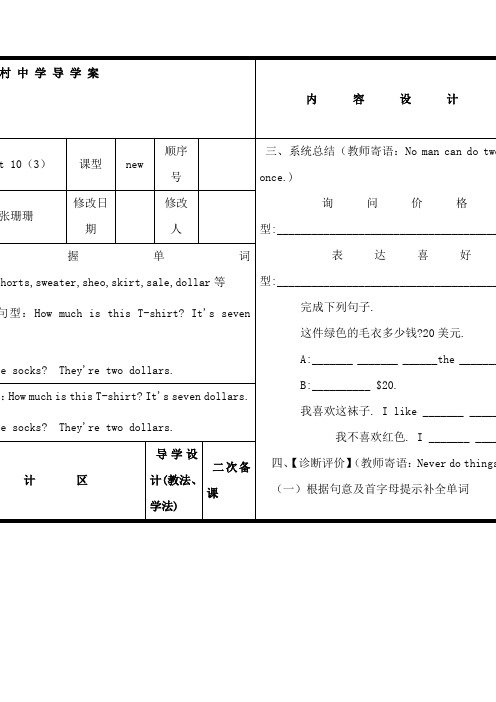
重 点 难 点
掌握询问价格的句型:How much is this T-shirt? It's seven dollars.
How much are these socks? They're two dollars.
内 容 设 计 区
导学设计(教法、学法)
二次备课
一、自主学习(教师寄语:Many hands make light work. )
学习任务一: 读写、记忆数字10-39,并默写.
1.听录音并跟读,熟读1a中的数字.
2.个人自读,记忆数字.
3.小组互相检查读、写情况.
4.写出下列数字并展示.
10 ________11________ 12________ 13________ 14 ________15 _____
3. Thank you.You're w__________. 4. My socks are not green. They are y__________.
(二)用英语写出下列数字.
1. How old is your uncle? He is ___________(25) years old.
表达喜好的句型:___________________________________________
完成下列句子.
这件绿色的毛衣多少钱?20美元.
A:_______ _______ ______the _______ ________?
B:__________ $20.
我喜欢这袜子. I like _______ ________.
新目标七年级英语unit10教学设计方案
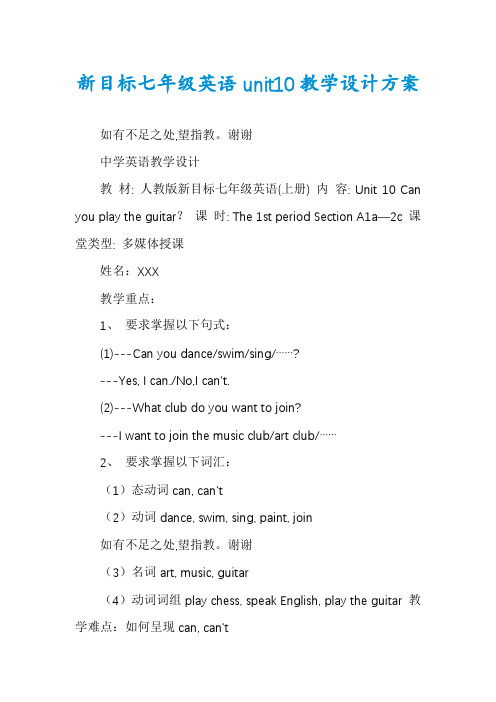
新目标七年级英语unit10教学设计方案如有不足之处,望指教。
谢谢中学英语教学设计教材: 人教版新目标七年级英语(上册) 内容: Unit 10 Can you play the guitar?课时: The 1st period Section A1a―2c 课堂类型: 多媒体授课姓名:XXX教学重点:1、要求掌握以下句式:(1)---Can you dance/swim/sing/……?---Yes, I can./No,I can’t.(2)---What club do you want to join?---I want to join the music club/art club/……2、要求掌握以下词汇:(1)态动词can, can’t(2)动词dance, swim, sing, paint, join如有不足之处,望指教。
谢谢(3)名词art, music, guitar(4)动词词组play chess, speak English, play the guitar 教学难点:如何呈现can, can’t教学目标:1. 知识目标:能够理解所学过的有关水果、蔬菜的单词,要求正确听、说、读、写单词:tomato,正确听、说、认读单词:eggplant, green pepper。
2. 能力目标:能够在情景中理解、会说、会用What’s this/ that in English?及答语It’s a/an… 渗透选择疑问句Is it green or red?的使用及回答It’s green.能够听懂句子Are you sure?会使用简短的指令语Show me……3. 过程和方法:通过探究学习和小组合作学习,激发学生的学习潜能,培养学生自主学习的能力和合作精神,培养学生的观察力和快速反应能力,提高学生的综合素质,为学生的终身学习和发展奠定基础。
4. 情感态度和价值观:能够在参与本单元的各项活动中体会到良好饮食习惯的重要性。
七年级英语上册unit 10教案
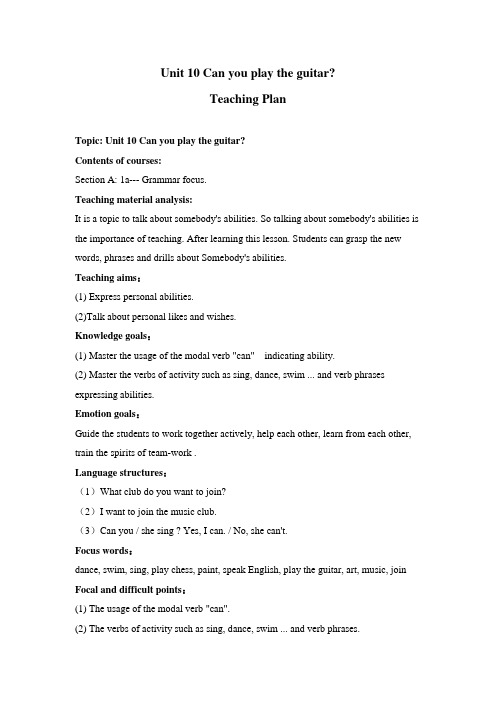
Unit 10 Can you play the guitar?Teaching PlanTopic: Unit 10 Can you play the guitar?Contents of courses:Section A: 1a--- Grammar focus.Teaching material analysis:It is a topic to talk about somebody's abilities. So talking about somebody's abilities is the importance of teaching. After learning this lesson. Students can grasp the new words, phrases and drills about Somebody's abilities.Teaching aims:(1) Express personal abilities.(2)Talk about personal likes and wishes.Knowledge goals:(1) Master the usage of the modal verb "can" indicating ability.(2) Master the verbs of activity such as sing, dance, swim ... and verb phrases expressing abilities.Emotion goals:Guide the students to work together actively, help each other, learn from each other, train the spirits of team-work .Language structures:(1)What club do you want to join?(2)I want to join the music club.(3)Can you / she sing ? Yes, I can. / No, she can't.Focus words:dance, swim, sing, play chess, paint, speak English, play the guitar, art, music, join Focal and difficult points:(1) The usage of the modal verb "can".(2) The verbs of activity such as sing, dance, swim ... and verb phrases.(3) The names of the clubs.Teaching methods:Task-based language teaching、create the language situation.Teaching steps :Step 1: Greeting and presentation (ppt).Greet the students in English. Then let the students listen to and sing an English song "Can you play the guitar?". Lead in the drills " Can you play the guitar?" and "I can play the guitar."Step2: Teaching new words and phrases.Today we learn a new unit ---Unit 10: Can you play the guitar? First we learn new words and phrases. Open your books at page 102. Please read after me. I read once, you read twice. Then let the students read the words by themselves for a few minutes. Step 3: Students practice.First let students read together. Then read the new words by boys and girls. Team 1. Team 2… and so on. Give them a result and encourage them.Step 4: 1aMatch the words with the people, check the answers. Then the teacher with the students sums up the names of clubs that the picture has, e.g. music club, chess club, English club, art club, swimming club, add sports club, dancing club and so on. (ppt) Step5: 1b Listen and number the conversations 1---3. Listen and repeat.Step6: Group work. (ppt)Tell the students that our headmaster really wants to know what your favorite clubs are, and what you can do .Each group makes a form like this:Each group choose one student as a interviewer, then he / she interview theothers ,choose another student as a reporter ,he / she fills in the form , then reports to the class. Before that , the teacher makes a model with a student:T: What club do you want to join?S: I want to join the music club.T: Can you play the guitar?S: Yes, I can. / No, I can't.Step7 : Listening text.Play the tape twice, (2a---2b, Page 60). Then let students circle the clubs and fill in the blanks.Step 8: Do exercises:(ppt)Ask and answer in pairs according to the pictures.Step 9: Homework.(1) Make a conversation like 2b.(2) Copy the Grammar Focus.板书设计:Unit 10 Can you play the guitar?1. What club do you want to join?2. I want to join the art club.3. I can play the guitar.4. Can you paint ? Yes, I can. / No, I can’t.。
人教版七年级英语《Unit.10.Where.did.you.go.on.vacation》教案

Unit 10 Where did you go onvacation?Topic: Holidays and vacationsFunctions: Talk about past eventsStructures:Past tense of regular and irregular verbswas / wereHow questionsTarget language: Where did you go on vacation?We went to New York City.Did you go to Central Park?Yes, I did.How was the weather?It was humid.Teaching StepsPeriod 1Good morning everyone! We have finished Unit 9. Today we are going to learn a new unit—Unit 10.Step 1: Lead inAsk and answera. Can you tell me what the title of Unit 10 is? Yes, it’s Where did you go on vacation? What do you think the unit is about?b. Yes. In this unit we are going to talk about past events.Step 2: Section A 1aIn Unit 9, we talked about the recent past activities and in this unit, we are going to continue talking about the past events.First, please open your books at Page 59 and look at activity 1a.1. Look and findLet’s look at activity 1a and find what the phrases mean.2. MatchYou know what the phrases mean. Please match them with the pictures.3. Check the answersHave you finished? Let’s check the answers one by one.Answers: 1. e 2. b 3. d 4. c 5. a 6. f 7. g4. Reada. Please read the phr ases after me. Stayed at home …b. Let’s read them together.c. Would you please read them one by one?Step 3: Section A 1b1. Listen and numberListen to the tape. And number the people from 1 to 5 in the picture. 2. Check the answersLet’s check the answers.Answers: 1. went to the mountains2. visited my uncle3. stayed at home4. went to New York City5. went to summer camp3. Reada. I would like you to read the conversations together.b. Would you please read them by yourselves three times?c. This time I would like you to read them twice with your partner.d. Who would like to read in class?Step 4: Section A 1cPairwork1. ReadWould you please read the conversation in 1c with your partner?2. Practicea. Would you please make conversations with your partner to talk about where the people went on vacation in activity 1a?b. Who would like to have a try in class?Step 5: Section A 2a1. ListenNow class, let’s move to activity 2a now. Please listen to the tape for the first time.2. MatchWhere did Nancy, Kevin and Julie go on vacation? Please match the person with the place when you listen to it for the second time.3. Check the answersHave you finished? Please check your answer with your partner and see whether your answers are the same. Let’s check them together.Answers: 1. c 2. a 3. bStep 6: Section A 2b1. Listen and checka. Listen to the conversation for the first time.b. Please check (√) “Yes, I did.” or “No, I didn’t.” for each question as you hear them talk.2. Check the answersHave you finished? Let’s check them.Answers: go to Central Park? Yes, I did.play volleyball? No, I didn’t.swim? Yes, I did.go to the movies? No, I didn’t.study for exams? Yes, I did.3. Reada. Let’s read the conversations together.b. I would like you to read them by yourselves.c. Who would like to have a try to read them in class?Step 7: Section A 2cGroupworka. Now class, let’s move to activity 2c.It’s a groupwork. Would you please role play conversations between Nancy, Kevin, and Julie?b. Who would like to have a try in class?c. Well done. Please pay attention to the past forms of the verbs in the phrases.Step 8: Grammar Focus1. ReadRead the sentences in the grammar box.2. Point out the notesSimple past tense Regular verbs Irregular verbsStep 9: SummarizeLet’s summarize what we learnt in this period.Step 10: Homework1. Copy the words in activity 1a and the sentences in the grammar box.2. Practice activity 2a and 2b.Period 2Step 1: Lead inWhat did we learn in Period 1? Who can tell us? Yes. We got to know how to talk about past events. Besides them, we learnt some regular verbs and some irregular verbs. Do you still remember how to say them? OK. Let’s review them first.Step 2: Revision1. Ask and answera. Would you please translate my Chinese into English? 拜访我的舅舅、参观博物馆……b. Please practice in pairs. Student A says in Chinese and student B translates it into English.2. DictationPlease take out your dictation exercise books and let’s have a dictation.Step 3: Section A 3a1. FillNow, let’s move to a new part of lessons. Would you please look at activity 3a on Page 61? Fill in the blanks with “was” or “were” in the c onversation.2. Check the answersI think all of you did well.Answer: 1. was 2. was 3. were 4. were 5. was 6. was 7. were 8. were3. Reada. Read the conversation with your partner.b. I would like you to read it together.c. Would you like to read it in class? Please have a try.4. Explainpretty good fantastic unfriendlyStep 4: Section A 3bPairworka. Just now, we learnt how to ask about the vacation. Now, I would like you to do a pairwork to ask and answer questions about the people’s vacations in 3b. Please follow the example in 3a.b. Who would like to have a try in class?Step 5: Section A 4Game—Vacation albumJust now, we talked about some people’s vacations. How about your vacations? Please make a photo album of vacations you enjoyed. Show the album to your classmates and talk about your vacations.Step 6: SummarizeLet’s summarize what we learnt in this period.Step 7: HomeworkCopy and try to recite the conversation in 3a.Period 3Step 1: Lead inGood morning, boys and girls. Shall we continue our lessons? Could you please tell me what we learnt in Section A? Yes. We learnt to talk about the weekend.Step 2: RevisionReviewa. I will show you some pictures and some information and please make conversations.b. Let’s have a dictation.Step 3: Section B 1a1. Looka. In Section A, we talked about the vacations with some description words. In Section B, we are going to learn more description words.b. Open your books at Page 62. Would you please look at activity 1a?c. Look at the words and the pictures.2. MatchPlease match the words with the pictures.3. Check the answersHave you finished, everyone? Let’s check them together.Answers: 1. f 2. a 3. d 4. e 5. b 6. cStep 4: Section B 1b1. WriteLet’s move to activity 1b. Do you think the words in 1a are happy words or unhappy words? Write happy words on the left and write unhappy words on the right.2. Check the answersCheck the answers with your friends.Answers:Happy words: delicious, cheap, not crowdedUnhappy words: awful, expensive, crowdedStep 5: Section B 2a1. Listen and answera. Let’s move to activity 2a now. It is a listening exercise. For the first time, I would like you to listen only.b. Now, for the second time, please listen to it again and answer the questions in activity 2a.2. Check the answersI think most of you have finished it. Let’s check them together.Answers: 1. She went to Tokyo.2. Yes, she did.Step 6: Section B 2b1. ListenListen to the conversation for the first time.2. Listen and filla. Listen to the conversation again and fill in the chart.b. Listen to the conversation again and check them by yourselves.3. Check the answersLet’s check the answers together.Answers: vacation: greatmuseums: interesting, crowdedstores: expensivepeople: friendlyfood: delicious4. Read the tapescripta. Let’s read the tapescript together.b. Would you please read the tapescript in pairs?c. Please translate the conversation into Chinese in pairs.d. Who would like to read in class?Step 7: Section B 2cPairworkRole play. Student A is Vera’s friend. Student B is Vera. Talk about Vera’s vacation. Use the information in the chart above. Student A begins questions with these words: Where did …? What did …? Did you …? How was …? How were …?Step 8: SummarizeLet’s summarize what we learnt in this period.Step 9: HomeworkPractice activity 2a and 2b in Section B.Period 4Step 1: Lead inWe have finished the most part of Unit 10. And in this period, we will continue to finish Section B. But before that, I would like you to review what we learnt before.Step 2: Revisions1. Make a speechCan you make a speech according to the chart to tell us your vacation?2. DictationLet’s have a dictation.Step 3: Section B 3a1. Reada. Let’s go into activity 3a on Page 63. There is a diary from Bob.b. Please read it by yourselves. If you have any questions, please ask me.c. I would like you to read it together.2. Circle and underlinePlease circle the good things about his vacation and underline the bad things.3. Check the answersI think most of you have finished. Please check your answers with your partner.Answers:Circled items: the weather (great)the beach (beautiful)playing in the water (fun)helping the little boy find his father (happy)playing tennis (really fun)eating Sichuan food (delicious)Underlined items: shops were too crowded (didn’t really enjoy them)museum (kind of boring)no money for taxi / walking back to hotel (tired)4. ExplainLet me explain some key words and phrases to you.all day have a fun doing sth. be crowded kind of find sb. doing sth. be lost help sb do sth. make sb. do sth. walk back to decide to do sth. all morning for dinnerStep 4: Section B 3b1. WriteImagine you are an American student on vacation in Beijing. Would you please write a travel diary according to the pictures given below?2. Reada. Please read your diary to your partner.b. Who would like to have a try to read it in class?Step 5: Section B 4GroupworkImagine you are all foreigners on vacation in China. You meet each other at the airport on your way home. Talk about what you did on your vacation.Step 6: SummarizeLet’s summarize what we did in this period.Step 7: HomeworkTry to recite the article in 3a.Period 5Step 1: Lead inWe have spent four periods on Unit 10. This is the last period of Unit 10. In this period, we will do some exercises and make sure you learn this unit well.Step 2: Self-check-11. Check the words and the phrases you knowOpen your books and look at Self-check-1. If you know the words and the phrases well, please check them.2. ReadI would like all of you to read the words and the phrases together.Step 3: Self-check-21. Do you have any other words you don’t know? Please write them in your exercise books.2. Please ask your friends for help.3. Looking up the dictionary is also a good way to study English. I hope you can get more from dictionaries.Step 4: Self-check-31. CompleteLet’s move to Self-check-3 now. First, I would like you to complete the form below.2. Make a surveya. Make questions about vacations. Write some questions about vacations.b. I would like you to ask your partner the questions you write and write down their answers.c. Discuss the best place for a vacation with your classmates.3. WriteWrite a report on student s’ vacations.Step 5: SummarizeLet’s summarize what we did in this period.Step 6: Homework1. Do the exercises on the Students’ Book and the textbook.2. Review Unit 10.3. Watch the pictures in Just for fun on Page 64.这份文件是人教版七年级英语《Unit 10 Where did you go on vacation?》的教案,主要涵盖了五个教学周期(Period)的内容,每个周期都详细规划了教学目标、教学活动、教学方法以及课后作业。
冀教版英语七年级下册Lesson10教学设计
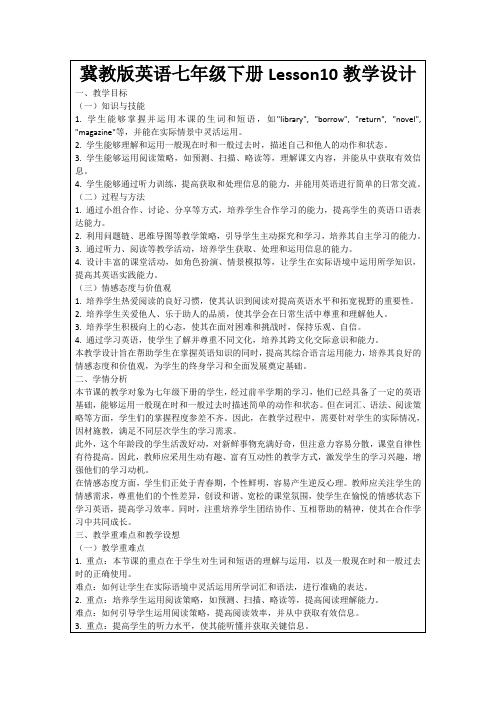
1.教师呈现课文图片,引导学生观察图片中的人物和物品,学习生词和短语,如"library", "borrow", "return", "novel", "magazine"等。
2.教师带领学生朗读课文,让学生注意听读生词和短语,并解释一般现在时和一般过去时的用法。
3.教师通过示例,讲解一般现在时和一般过去时的区别,并让学生进行模仿练习。
3.鼓励学生自主完成作业,培养其独立思考和解决问题的能力。
4.作业布置要具有针对性和实效性,关注学生的个体差异,满足不同层次学生的需求。
(2)通过课堂讨论、小组合作等形式,培养学生团结协作、互相帮助的精神。
(3)结合教学内容,引导学生树立正确的人生观、价值观。
四、教学内容与过程
(一)导入新课
1.教师以图片展示一个图书馆的场景,引导学生观察并提问:“What can you see in the picture? Do you like reading books? Why?”通过这个问题,激发学生的兴趣,引入本课的主题——图书馆。
b. Match the following words with their meanings.
c. Answer the questions based on the reading passage.
2.学生完成练习题,教师进行讲解和反馈。
(五)总结归纳
1.教师引导学生回顾本节课所学内容,包括生词、短语、语法和阅读策略。
冀教版英语七年级下册Lesson10教学设计
一、教学目标
(一)知识与技能
1.学生能够掌握并运用本课的生词和短语,如"library", "borrow", "return", "novel", "magazine"等,并能在实际情景中灵活运用。
英语北师大出版社七年级下lesson10教学设计.docx

教学设计课题Unit 4 Interest and skills Lesson 10 My Interests教材义务教育教科书《英语》七年级上册(北京师范大学出版社)授课教师陈思授课班级七年一班指导思想与理论依据《英语课程标准》实施建议中指出:活动耍有明确的交流目的,真实的交流意义和具体的操作要求,并为学生提供展示学习成果的机会。
使学生能在个体和合作的实践活动中发展语言与思维能力,并能在展示活动中感受成功。
初一应达到三级标准,即能听懂有关熟悉话题的语段,能与教师或同学就熟悉的话题交换信息,能根据提示参与简单的角色表演等活动。
教材分析本课为北师大版教材七年级英语第四单元第10课,为本单元第一课。
单元话题是谈论兴趣与技能,涉及《英语课程标准》话题第一项“个人情况''中第4子话题“兴趣与爱好第10课承接Unit 1中个人喜好的话题,讨论学生们的兴趣,为后两课有关技能话题学习做铺垫。
本节课为第10课的第一课时,侧重对对话的理解和语言的梳理。
对话以选报社团为主线,以Ann, Lucy, Alex三人对话的形式呈现如何表述自己的兴趣爱好。
学牛通过阅读对话,感受依据任务获取信息的阅读策略。
初步感知同意、不同意的功能意念。
最终能达到初步运用所学语言表达个人兴趣。
学情分析1、自然情况本节课的教学对象是七年级一班学生,共21人。
一部分学生英语基础比较扎实,对英语学习有较高热情,喜欢参与课堂活动,也具有一定的听说能力,能进行简单交流。
还有一部分学生基础薄弱,词汇量有限,理解本课内容有一定难度。
针对这种差异,我在课堂问题的设置上进行了分层处理,小台阶,多步骤分层次处理文章,为基础薄弱的学生提供展示自己的机会,同时也能让表达能力较强的同学有些挑战。
2、已有基础学生在小学阶段学过相关话题的词汇和简单表达,能用I like…表达喜好。
也了解了特殊疑问词where, which的含义。
本册书Unit 1 lesson 3也学习了关于个人爱好的词汇及句式,相对减少了学生的学习障碍。
第十课 Lesson Ten_七年级英语教案
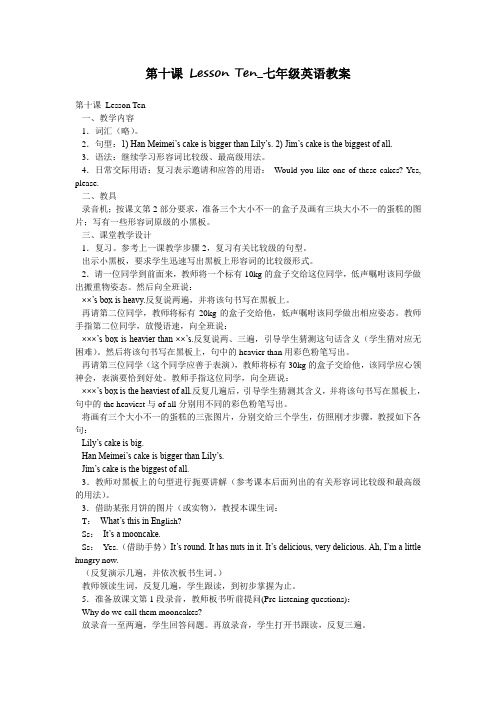
第十课 Lesson Ten_七年级英语教案第十课Lesson Ten一、教学内容1.词汇(略)。
2.句型:1) Han Meimei’s cake is bigger than Lily’s. 2) Jim’s cake is the biggest of all.3.语法:继续学习形容词比较级、最高级用法。
4.日常交际用语:复习表示邀请和应答的用语:Would you like one of these cakes? Yes, please.二、教具录音机;按课文第2部分要求,准备三个大小不一的盒子及画有三块大小不一的蛋糕的图片;写有一些形容词原级的小黑板。
三、课堂教学设计1.复习。
参考上一课教学步骤2,复习有关比较级的句型。
出示小黑板,要求学生迅速写出黑板上形容词的比较级形式。
2.请一位同学到前面来,教师将一个标有10kg的盒子交给这位同学,低声嘱咐该同学做出搬重物姿态。
然后向全班说:××’s box is heavy.反复说两遍,并将该句书写在黑板上。
再请第二位同学,教师将标有20kg的盒子交给他,低声嘱咐该同学做出相应姿态。
教师手指第二位同学,放慢语速,向全班说:×××’s box is heavier than ××’s.反复说两、三遍,引导学生猜测这句话含义(学生猜对应无困难)。
然后将该句书写在黑板上,句中的heavier than用彩色粉笔写出。
再请第三位同学(这个同学应善于表演),教师将标有30kg的盒子交给他,该同学应心领神会,表演要恰到好处。
教师手指这位同学,向全班说:×××’s box is the heaviest of all.反复几遍后,引导学生猜测其含义,并将该句书写在黑板上,句中的the heaviest与of all分别用不同的彩色粉笔写出。
将画有三个大小不一的蛋糕的三张图片,分别交给三个学生,仿照刚才步骤,教授如下各句:Lily’s cake is big.Han Meimei’s cake is bigger than Lily’s.Jim’s cake is the biggest of all.3.教师对黑板上的句型进行扼要讲解(参考课本后面列出的有关形容词比较级和最高级的用法)。
新冀教版七年级下册英语 Lesson 10 教案
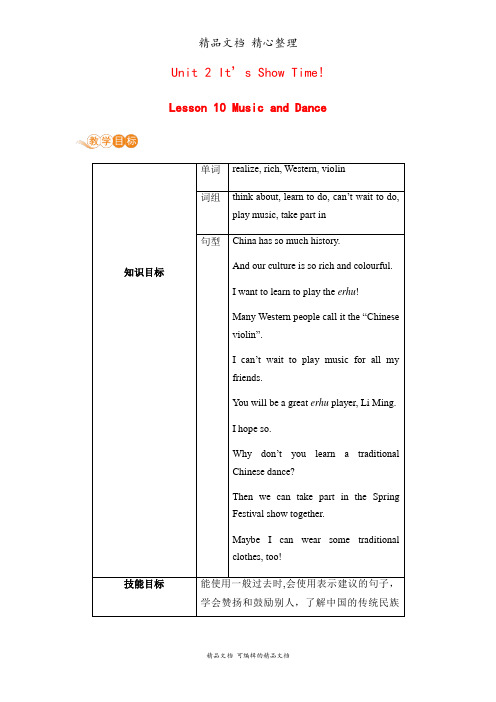
Unit 2 It’s Show Time! Lesson 10 Music and Dance单词realize, rich, Western, violin1.能听懂和写关于民族文化和历史的对话2.学会运用一般过去时和提出建议的句子正确使用本课的词和短语,分辨、会用realize, rich, Western, violin, think about, learn to do, can’t wait to do, play music, take part in。
Step 1.Lead inLeading in 【情景1】Warm up:Show some pictures about Chinese traditional instruments.Let students get to know about them.Teacher points to the pictures and asks questions:T:What is it?S1:It’s the erhu.T:Can you play it?S1:Yes, but only a little.T:What is this?S2:We call it guzheng.T:Can you play it?S2:Yes,I can play it very well.T:When did you learn to play it?S:When I was eight years old.Leading in 【情景2】Group work:Ask the students to work in groups and discuss the following questions:How can we encourage others in Chinese? Now, in English, how can we encourage others? And how can we praise others? The students can create different situations to practice them.Teacher asks the students some questions about Lanzhou.S1:××,I want to learn to play the erhu.S2:It’s a good idea.I think you will do it very well.S3:I pass the driving test.S4:Well done.You did a very good job.S5:××,I like writing very much.S6:I hope you will be a great writer.S5:I hope so.Step 2.Presentation1.Teacher should teach the new words and phrases in this part:realize, rich, Western, violin, think about, can’t wait to do, play music, take part in.Teacher leads the students to learn the new words and phrases.Then make sentences with the new words and phrases.Teacher can use objects and pictures.Teacher points to a picture and asks the students.T:What is it?S1:It’s a violin.T:Now read after me “violin”.S:Violin.T:Is the Western culture rich?S2:Yes,I think so.T:Read after me “rich”.S:Rich.2.Pair work:Ask the students to work in pairs to make conversations.Try to use the new words and expressions.S3:During the trip to London, I realized many things.S4:What are they?S3:The culture in England is very rich and colourful.S4:What else?S3:I can see people play music on the street.Step 3.Practice1.Ask the students to retell the story with their own words.2.Ask the students to practice how to give advice.S1:Shall we go to see a movie tonight?S2:Let’s go shopping this afternoon.S3:What about staying at home tonight?S4:How about sending him an e-mail?S5:Why don’t we buy a new car?S6:Why not go fishing?S7:Would you like to go swimming?3.Work in groups:Ask your group members what they are good at.Write their answers in a table and make a report in front of the class.Now discuss for several minutes.Then ask some groups to show their reports.Group 1:I have many good friends.They are very clever.They are good at playing sports, singing, dancing and so on.Let me tell you something about them.Mike is good at playing sports.He plays basketball very well.John does well in drawing.He won the first place in our school drawing petition last week.Step 4.TaskWork in pairs.What are you good at? Can you sing or dance? Can you draw or play an instrument?Write a short passage about something you are good at.Present it to the class and show your classmates what you can do!Task tips:What is your talent? When did you start to develop this talent? Where or how do you practice your talent?Ask the students to practice for a few minutes.Then let some groups read their passages.1.Learn the new words and expressions by heart.2.Write a short passage about something you are good at.。
北师大版英语七年级上册Lesson10MyInterests2教学设计
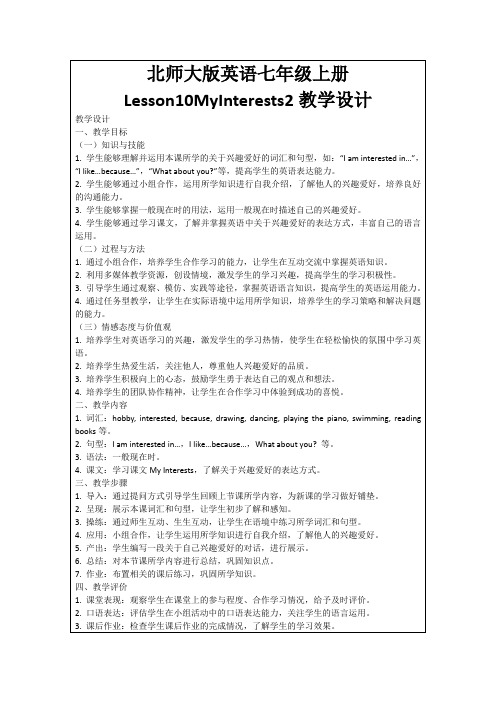
1.写作练习:请于课后完成,注意语法和词汇的正确性,可参考教材中的例句进行仿写。
2.对话创编:在下节课前,与搭档共同完成对话创编,并在课堂上进行展示。
3.课后阅读:阅读文章后,完成相关阅读理解题目,提高阅读分析能力。
北师大版英语七年级上册Lesson10MyInterests2教学设计
教学设计
一、教学目标
(一)知识与技能
1.学生能够理解并运用本课所学的关于兴趣爱好的词汇和句型,如:“I am interested in…”,“I like…because…”,“What about you?”等,提高学生的英语表达能力。
3.引导学生观察例句,发现并总结一般现在时的用法,如:“I like playing football because it makes me feel excited.”
4.通过师生互动、生生互动,让学生练习使用一般现在时描述自己的兴趣爱好。
5.讲解并示范如何用英语询问他人的兴趣爱好,如:“What about you? Do you like playing football, too?”
2.使学生能3.培养学生在实际语境中运用所学知识进行自我介绍和了解他人兴趣爱好。
(二)教学难点
1.学生对一般现在时态的掌握,特别是在具体语境中的应用。
2.描述兴趣爱好时,词汇和句型的灵活运用。
3.学生在互动交流中,克服恐惧心理,勇于表达自己。
(三)教学设想
1.创设情境,激发兴趣:利用多媒体教学资源,展示与兴趣爱好相关的图片和视频,激发学生的学习兴趣,引导学生主动参与到课堂活动中。
2.利用多媒体教学资源,创设情境,激发学生的学习兴趣,提高学生的学习积极性。
3初一英语上册教案unit 10
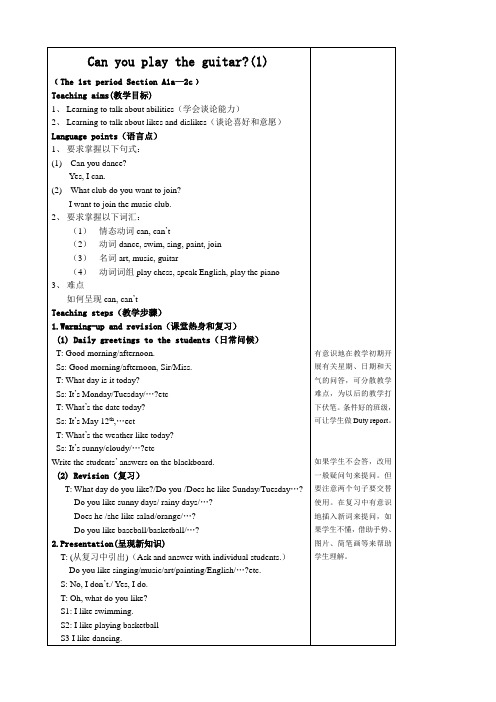
(1) do (4) Club
(2) To (5) play
(3) want (6) can’t
T: Now let’s listen to the tape again and repeat. Ask some students to read the dialogue loudly.
(1) Daily greetings to the students(日常问候)
T: Good morning/afternoon.
Ss: Good morning/afternoon, Sir/Miss.
T: What day is it today?
Ss: It’s Monday/Tuesday/…?etc
Boy: Me, too. Let’s join the music club.
4. Make a survey(调查)
T: Our school has many clubs. What clubs do you want to join? Please ask and answer in groups. Write down your group members’answers in the form. And then give us a report.
Can you play the guitar?(1)
﹙The 1st period Section A1a—2c﹚
Teaching aims(教学目标)
1、Learning to talk about abilities(学会谈论能力)
2、Learning to talk about likes and dislikes(谈论喜好和意愿)
T: Oh, what do you like?
七年级上册Unit 10 (教学设计)
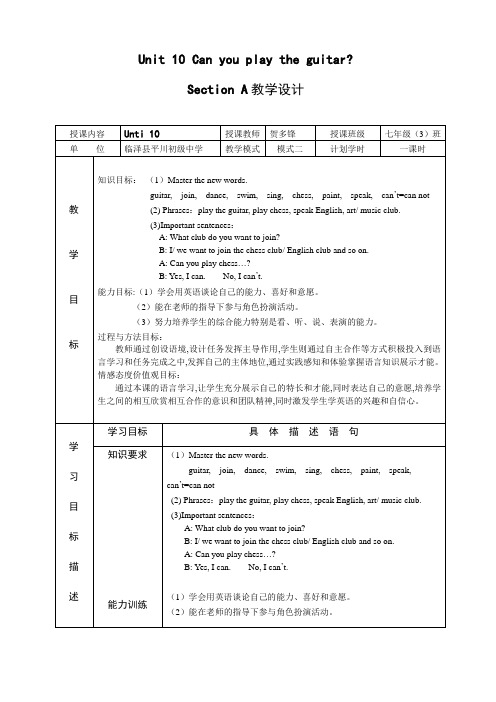
教 学 过 程 设 计
学习 目标
媒体 类型
媒体内容 要 点
媒体 作用
所得结果
教
新单词
①图片资料
展示部分单词的实 物照片或部分动词 的动画图片。
引起学生想学英语 的兴趣。 帮助学生纠正发
激发了学生学习英语 的兴趣。 创设了较好的英语学 主与合作学习的习惯。
学 媒 体 新对话 的 听力练习 选 择
②音频资料
学情分析
情景会话和活动表演中加以落实,提高综合运用语言的能力,使各层 次的学生都有所收获。 2、 授课遵循由易到难、由静到动,循序渐进推进课堂进程。
Step 1.Warm-up 1. Greetings. 2. Free talk. Step 2. Leading Show a picture of guitar to present the topic and teach “guitar”、 “play the guitar”. Step 3. Teaching new words 1. Game of guessing words: The teacher does and students guess words. (swim, sing, paint). 2. Show the chess to teach word “chess”. 3. Show the picture to study “speak English, dance”. 4. Read the new words after the tape. 5. Words exercises: Match the words and the people. Step 4. presentation and action 1. Use new words to talk with students and practice in pairs. T: Can you/ he/ she dance…? Ss: Yes, I/ he/ she can. No, I/ he/ she can’t. 2. Lead the new phrases and important sentences to make a new dialogue, then practice. A: What club do you want to join? B: I/ we want to join the chess club/ English club and so on. A: Can you play chess…? Ss: Yes, I can. No, I can’t. Step 5. Groupwork: Make a new dialogue. Step 6. Exercises 1. Listening exercises.(1b, 2a) 2. Listen and complete the dialogue. (2b) Step 7. Actilities. Step 8.Summary. (PPT) Step 9. Homework Write a short passage about their family members’ abil录音,听力 的练习。
- 1、下载文档前请自行甄别文档内容的完整性,平台不提供额外的编辑、内容补充、找答案等附加服务。
- 2、"仅部分预览"的文档,不可在线预览部分如存在完整性等问题,可反馈申请退款(可完整预览的文档不适用该条件!)。
- 3、如文档侵犯您的权益,请联系客服反馈,我们会尽快为您处理(人工客服工作时间:9:00-18:30)。
( 英语教案 )
学校:_________________________
年级:_________________________
教师:_________________________
教案设计 / 精品文档 / 文字可改
七年级英语:第十课 Lesson
Ten(教学方案)
Learning English is conducive to making friends, chatting or working together with foreigners, and learning English is very useful for traveling abroad.
七年级英语:第十课 Lesson Ten(教学方
案)
一、教学内容
1.词汇(略)。
2.句型:1) Han Meimei's cake is bigger than Lily's. 2) Jim's cake is the biggest of all.
3.语法:继续学习形容词比较级、最高级用法。
4.日常交际用语:复习表示邀请和应答的用语: Would you like one of these cakes? Yes, please.
二、教具
录音机;按课文第2部分要求,准备三个大小不一的盒子及画有三块大小不一的蛋糕的图片;写有一些形容词原级的小黑板。
三、课堂教学设计
1.复习。
参考上一课教学步骤2,复习有关比较级的句型。
出示小黑板,要求学生迅速写出黑板上形容词的比较级形式。
2.请一位同学到前面来,教师将一个标有10kg的盒子交给这位同学,低声嘱咐该同学做出搬重物姿态。
然后向全班说:××'s box is heavy.反复说两遍,并将该句书写在黑板上。
再请第二位同学,教师将标有20kg的盒子交给他,低声嘱咐该同学做出相应姿态。
教师手指第二位同学,放慢语速,向全班说:×××'s box is heavier than ××'s.反复说两、三遍,引导学生猜测这句话含义(学生猜对应无困难)。
然后将该句书写在黑板上,句中的heavier than用彩色粉笔写出。
再请第三位同学(这个同学应善于表演),教师将标有30kg的盒子交给他,该同学应心领神会,表演要恰到好处。
教师手指这位同学,向全班说:
×××'s box is the heaviest of all.反复几遍后,引导学生猜测其含义,并将该句书写在黑板上,句中的the heaviest与of all分别用不同的彩色粉笔写出。
将画有三个大小不一的蛋糕的三张图片,分别交给三个学生,仿照刚才步骤,教授如下各句:
Lily's cake is big.
Han Meimei's cake is bigger than Lily's.
Jim's cake is the biggest of all.
3.教师对黑板上的句型进行扼要讲解(参考课本后面列出的有关形容词比较级和最高级的用法)。
3.借助某张月饼的图片(或实物),教授本课生词:
T: What's this in English?
Ss: It's a mooncake.
Ss: Yes.(借助手势)It's round. It has nuts in it. It's delicious, very delicious. Ah, I'm a little hungry now.
(反复演示几遍,并依次板书生词。
)
教师领读生词,反复几遍,学生跟读,到初步掌握为止。
5.准备放课文第1段录音,教师板书听前提问(Pre-listening questions):
Why do we call them mooncakes?
放录音一至两遍,学生回答问题。
再放录音,学生打开书跟读,反复三遍。
6.用同样方法处理课文第3部分。
听前提问可以设计为:
Does Lucy like eating mooncakes?
教师扼要讲解本课中出现的难点(见难点讲解)。
7.布置作业
1)听录音,练习朗读本课对话;2)抄写生词及短语;抄写课文第2部分内容;3)完成练习册习题。
四、难点讲解
1.Would you like one of these mooncakes?请挑一块月饼吃吧。
Would you like…?是表示非常客气的邀请。
用在本课中,指韩美美很有礼貌、客气地向对方礼让,请露西吃一块月饼,one of these mooncakes直译为:这些月饼中的一块。
表明韩美美一下子为露西拿出几块月饼,邀其品尝。
one of…意为“……之一”。
例如:
There are twenty-four boys in the class. One of them is English.在班里有24名男孩,其中之一是个英国男孩。
对Would you like…?的应答用语,肯定回答一般为: Yes, please.如想表示拒绝,要注意口气的委婉。
可以答作: No, thank you.(参阅下一课第1部分)。
2.Can't you see?你没看见吗?
这是一般疑问句的否定形式,简称否定疑问句,用来表示说话人的惊奇、责难、建议等。
例如:
Don't you ususally come to school by bike?你平常来学校不是骑自行车吗?(表示说话人的惊奇,因对方没有骑车。
)否定疑问句的构成是在一般疑问句的主语之后加not。
但在实际应用中,都使用简略式。
可在这填写你的名称
YOU CAN FILL IN THE NAME Here。
